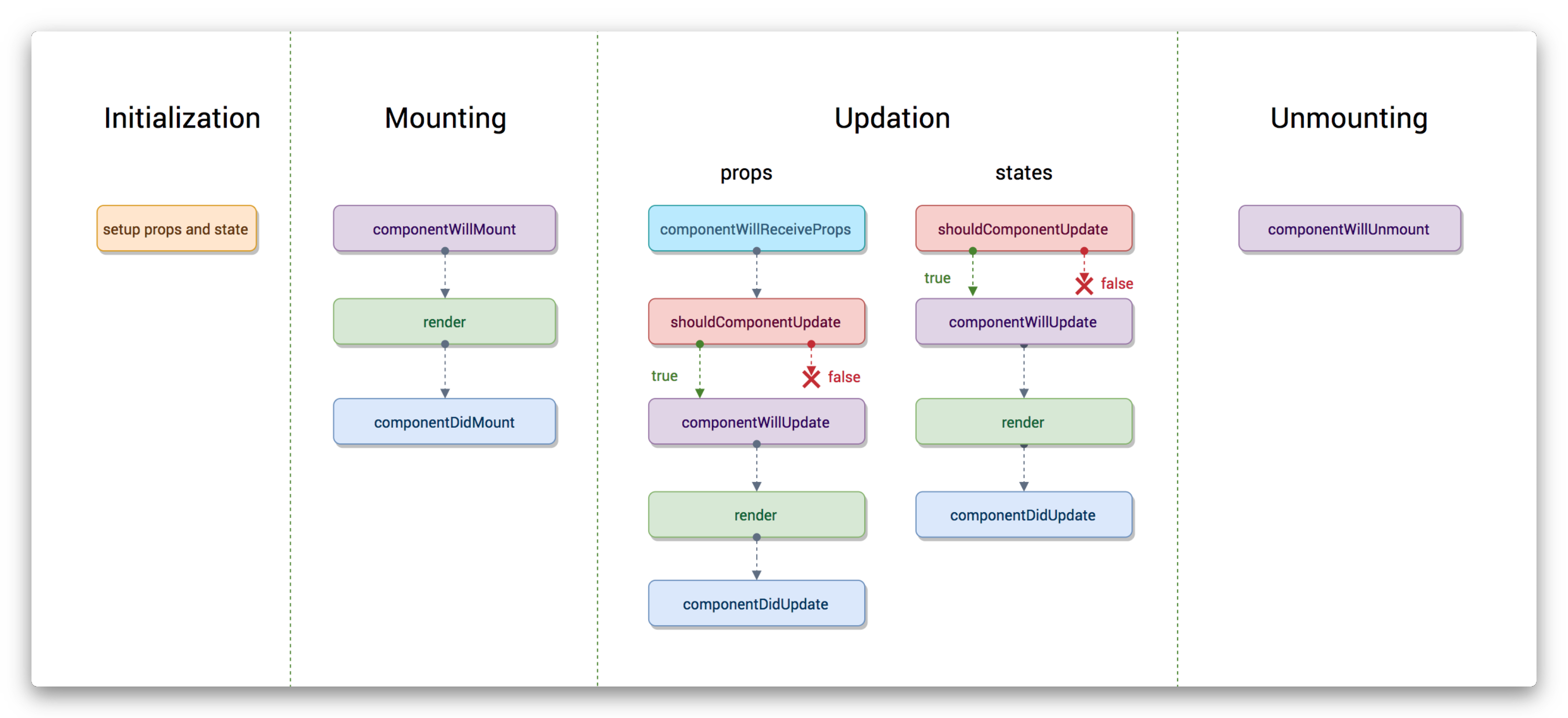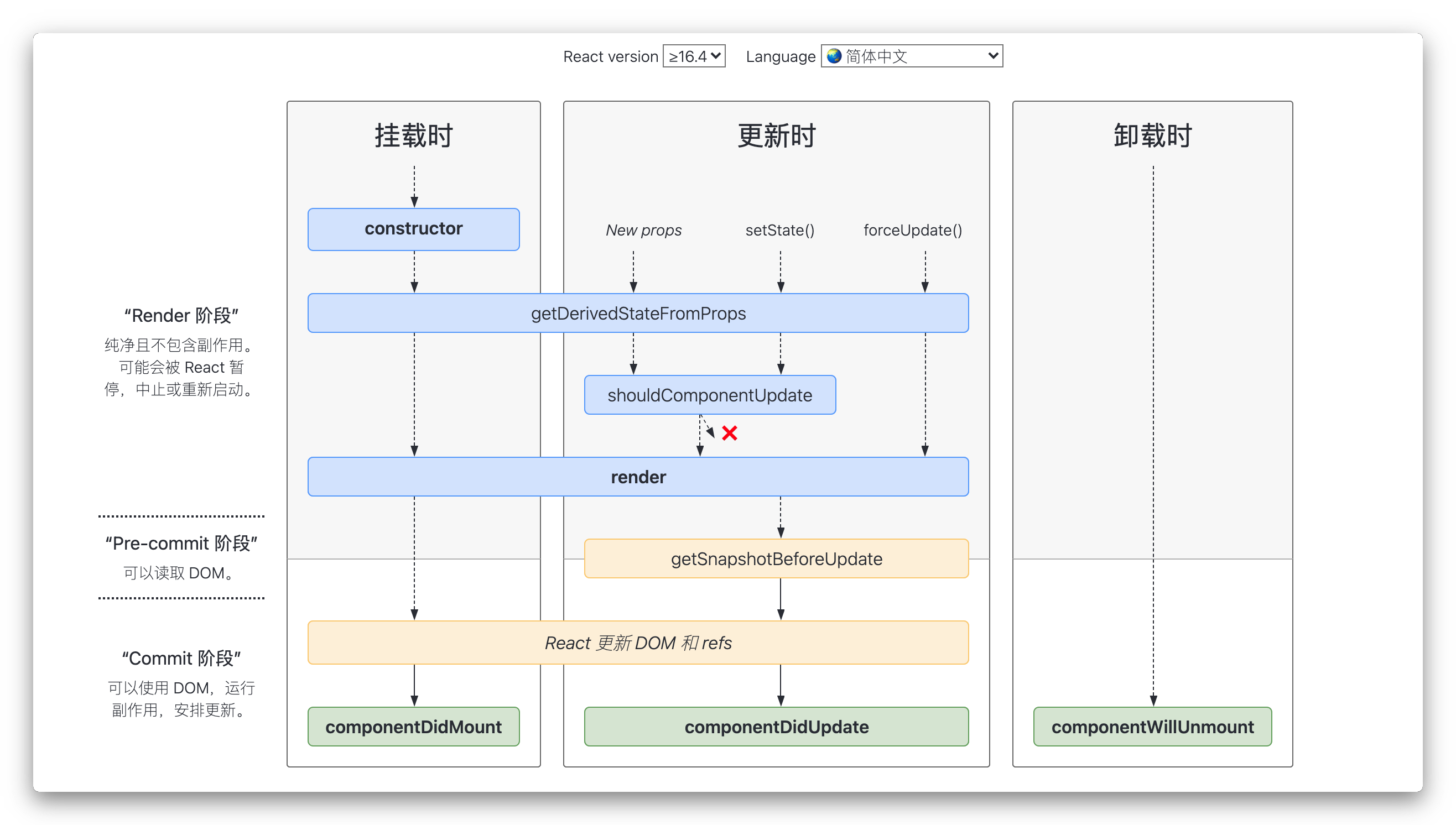组件有不同的生命周期,也就是有不同的阶段。通过生命周期方法,我们可以指定在不同阶段的行为。
比如:
- 在组件挂载后,请求网络数据、订阅数据,设置定时器等。
- 在组件更新前,通过判断 props 或者 state 控制组件是否更新,从而实现性能优化。
- 在组件卸载销毁前,清理定时器,取消数据的订阅。
参考资料
运行demo
参考我的 github 上的 react-lifecycle-demo
React 的生命周期变化
React 16 前
生命周期有:
- constructor()
- componentWillMount()
- render()
- componentDidMount()
- componentWillReceiveProps(nextProps)
- shouldComponentUpdate(nextProps, nextState)
- componentWillUpdate(nextProps,nextState)
- componentDidUpdate(prevProps, prevState)
- componentWillUnmount()
之前的生命周期图谱:
图片来自:https://hackernoon.com/reactjs-component-lifecycle-methods-a-deep-dive-38275d9d13c0?gi=630d5f23e5a
React 16 后
因为 React 使用了 Fiber 的结构,之前在 render 之前的生命周期函数有可能会被执行多次,所以删除了以下生命周期函数,过渡方案就是添加UNSAFE_前缀,过渡方案可使用至 React 17
componentWillReceiveProps- 暂时可用 UNSAFE_componentWillReceiveProps
componentWillUpdate- 暂时可用 UNSAFE_componentWillUpdate
componentWillMount- 暂时可用 UNSAFE_componentWillMount
可以使用 rename-unsafe-lifecycles 这个工具,将工程中旧的生命周期函数名更改到过渡的生命周期名
新增了:
- static getDerivedStateFromProps()
- getSnapshotBeforeUpdate()
- static getDerivedStateFromError()
- componentDidCatch()
也可使用 static getDerivedStateFromProps()、getSnapshotBeforeUpdate() 这两个新的生命周期函数替代被删除掉的componentWillReceiveProps、componentWillUpdate和componentWillMount
React 16 的生命周期图谱
16.3:
版本>= 16.4 的:
图片来自:https://projects.wojtekmaj.pl/react-lifecycle-methods-diagram/
React的生命周期详解
初始化阶段
constructor()
也就是执行 constructor 这个阶段,这时候一般用于初始化 state 状态
挂载阶段
componentWillMount()
1 | componentWillMount() |
- 在挂载阶段,render前面被调用。
- 它在 render() 之前调用,因此在此方法中同步调用 setState()不会触发额外渲染。通常,我们建议使用 constructor() 来初始化 state。
- 避免在此方法中引入任何副作用或订阅。如遇此种情况,请改用 componentDidMount()。
- 在 16.3及以后,更名为
UNSAFE_componentWillMount(),可以被使用至 react17
static getDerivedStateFromProps()
1 | static getDerivedStateFromProps(props, state) |
- 调用 render 方法之前调用,并且在初始挂载及后续更新时都会被调用。
- 它应返回一个对象来更新 state,如果返回 null 则不更新任何内容。
- 16.3 的时候,forUpdate不会触发
getDerivedStateFromProps,后面16.3 后 forceUpdate() 同样会触发getDerivedStateFromProps - 在每次渲染前都会执行,而对比之下,废除的
componentWillReceiveProps则只在父组件重新渲染的时候触发
派生状态会导致代码冗余,并使组件难以维护。 确保你已熟悉这些简单的替代方案:
- 如果你需要执行副作用(例如,数据提取或动画)以响应 props 中的更改,请改用 componentDidUpdate。
- 如果只想在 prop 更改时重新计算某些数据,请使用 memoization helper 代替。
- 如果你想在 prop 更改时“重置”某些 state,请考虑使组件完全受控或使用 key 使组件完全不受控 代替。
render()
1 | render() |
- 根据 props 以及 state 获取虚拟 dom
- render 是 class 组件必需要实现的方法
- render 函数可以返回以下类型
- React 元素
- 数组或 fragment
- Portals。可以渲染子节点到不同的 DOM 子树中
- 字符串或者数值类型。
- null 或者 布尔类型,不会渲染任何东西
componentDidMount()
1 | componentDidMount() |
- 将组件挂载(插入到 dom树后)立即执行。
- 可在此处订阅和请求数据,获取到 dom 的一些信息。
- 在此处 setState 会导致两次渲染,但此次渲染会发生在浏览器更新屏幕前。因此在两次调用下,用户也不会看到中间状态。
更新阶段
更新阶段主要有三种情形:
- 父组件渲染,导致 props 改变,触发组件更新
- 组件使用 setState() 改变组件内部 state,触发更新
- 使用 forceUpdate() 方法
componentWillReceiveProps()
1 | componentWillReceiveProps(nextProps) |
- 在已挂载的组件接受新的 props 触发。(不会在接受初始 props 的时候更新,而是在更新 props 后更新)
- 如果父组件导致组件重新渲染,即使 props 没有更改,也会调用此方法。
- 在16.3及以后更名为
UNSAFE_componentWillReceiveProps,可继续使用至 React 17,后续将废置
shouldComponentUpdate()
1 | shouldComponentUpdate(nextProps, nextState) |
- 在已挂载组件接受新 props 或者 更新了 state 的时候触发
- 返回 true 表示允许组件更新, 返回 false 表示跳过此次更新
- 通常通过
this.state和nextState,this.props和nextProps的比较,控制是否更新,从而实现性能优化
componentWillUpdate()
1 | componentWillUpdate(nextProps, nextState) |
- 触发时机:在更新阶段 shouldComponentUpdate 为 true 之后,render 阶段之前触发
- 不应该执行 setState 或者 redux 等触发组件更新的操作,否则会死循环
- 在 React 16.3 及以后,更名为
UNSAFE_componentWillUpdate,后续将会删除这个生命周期,可使用至 React 17
render()
1 | render() |
同挂载阶段的 render函数
componentDidUpdate()
1 | componentDidUpdate(prevProps, prevState, snapshot) |
- 触发时机:在组件更新阶段,dom 完成更新挂载后立即执行。
- 组件更新后,可以再次获取到更新后的 dom 信息。
- 可以在这里对比更新的 props 或者 state,判断是否要请求数据更新
- 在这里可以直接使用 setState,但必需要有条件才更新组件,否则会引发更新组件的死循环
- (React 16.3及以后)如果组件实现了 getSnapshotBeforeUpdate() 生命周期(不常用),则它的返回值将作为 componentDidUpdate() 的第三个参数 “snapshot” 参数传递。
getDerivedStateFromProps()
同上面挂载阶段的描述
getSnapshotBeforeUpdate()
1 | getSnapshotBeforeUpdate(prevProps, prevState) |
- 触发时机:在最近一次渲染输出(提交到 DOM 节点)之前调用
- 可以获取到组件更新前 dom 的一些信息(比如滚动信息)
- 返回值会作为 componentDidUpdate 的第三个参数 snapshot
官方文档上,获取更新前的滚动位置信息的一个例子:
1 | class ScrollingList extends React.Component { |
卸载阶段
卸载阶段只有一个生命周期函数:
- componentWillUnmount
componentWillUnmount()
1 | componentWillUnmount() |
- 触发时机:在组件卸载销毁前,执行该方法。
- 通常用于一些清理操作:清除定时器,取消数据订阅等
错误边界
在 React 16 后,若组件发生 js 错误,将不会显示错误的组件,而是显示一片空白。
通过错误边界,可以显示降级的UI 而不是显示错误的组件树或一片空白。错误边界是 React 的组件,可在子树中捕获到 javascript 错误,并记录这些错误。
错误边界在渲染期间、生命周期方法和整个组件树的构造函数中捕获错误。
错误边界不可以捕获以下错误:
- 事件处理
- 异步代码
- 服务端渲染
- 自身组件抛出的错误
static getDerivedStateFromError()
1 | static getDerivedStateFromError(error) |
- 触发时机:在后代组件中抛出错误的时候触发
- 接受抛出的错误作为参数,返回的值将会更新state,可根据该 state 控制显示的降级UI
- 因为
getDerivedStateFromProps会在渲染阶段调用,所以不允许使用副作用,若要实现副作用,请使用componentDidCatch
根据错误,显示降级 UI 的例子:
1 | class ErrorBoundary extends React.Component { |
componentDidCatch()
1 | componentDidCatch(error, info) |
- 触发时机:在后代组件中抛出错误的时候触发,发生在 commit 阶段,因此可以使用副作用
- 返回的参数为
- error: 错误信息
- info: 带有 componentStack Key 的信息
官方文档的例子:
1 | class ErrorBoundary extends React.Component { |
错误边界的使用方法:
1 | <ErrorBoundary> |